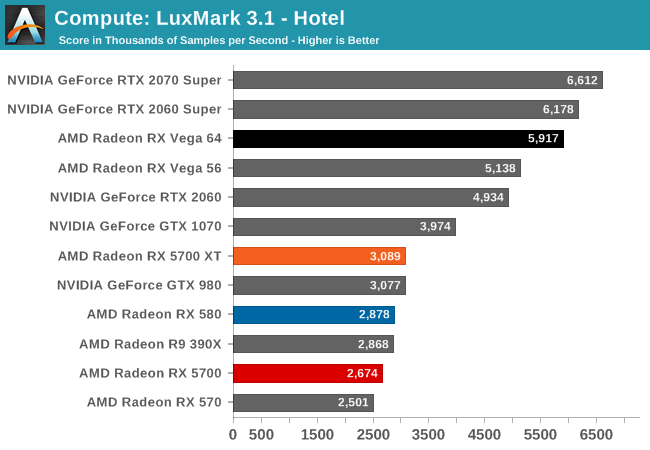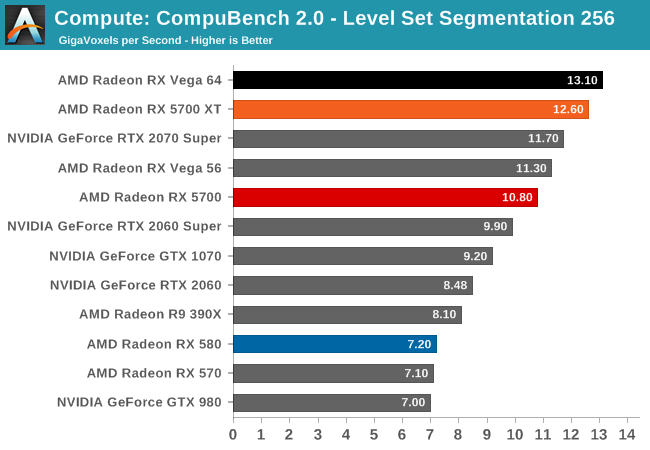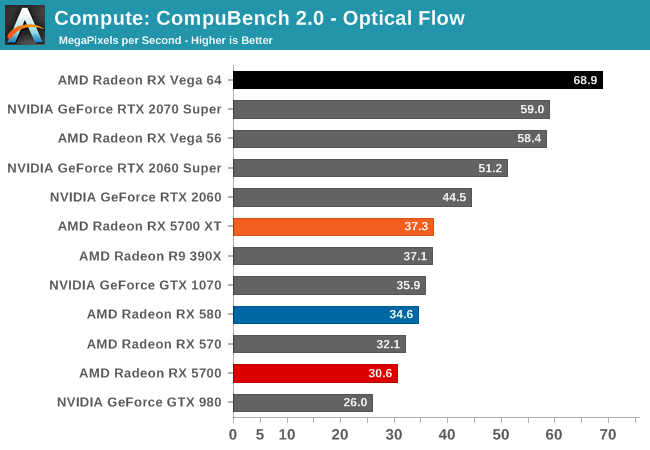The AMD Radeon RX 5700 XT & RX 5700 Review: Navi Renews Competition in the Midrange Market
by Ryan Smith on July 7, 2019 12:00 PM ESTCompute
Unfortunately, as I mentioned earlier in my testing observations, the state of AMD's OpenCL driver stack at launch is quite poor. Most of our compute benchmarks either failed to have their OpenCL kernels compile, triggered a Windows Timeout Detection and Recovery (TDR), or would just crash. As a result, only three of our regular benchmarks were executable here, with Folding@Home, parts of CompuBench, and Blender all getting whammied.
And "executable" is the choice word here, because even though benchmarks like LuxMark would run, the scores the RX 5700 cards generated were nary better than the Radeon RX 580. This a part that they can easily beat on raw FLOPs, let alone efficiency. So even when it runs, the state of AMD's OpenCL drivers is at a point where these drivers are likely not indicative of anything about Navi or the RDNA architecture; only that AMD has a lot of work left to go with their compiler.
That said, it also serves to highlight the current state of OpenCL overall. In short, OpenCL doesn't have any good champions right now. Creator Apple is now well entrenched in its own proprietary Metal ecosystem, NVIDIA favors CUDA for obvious reasons, and even AMD's GPU compute efforts are more focused on the Linux-exclusive ROCm platform, since this is what drives their Radeon Instinct sales. As a result, the overall state of GPU computing on the Windows desktop is in a precarious place, and at this rate I wouldn't be entirely surprised if future development is centered around compute shaders instead.













135 Comments
View All Comments
Ryan Smith - Sunday, July 7, 2019 - link
Hey all,As you've probably noticed, this review is a bit bare-bones on information outside of benchmarks. With 2 video card launches in the span of a week - not to mention AMD's very important CPU launch - I've been stretched a bit thin trying to get everything to fall into place.
So with the basics done and all of the benchmarks processed, I'm posting this now to let you all see how the RX 5700 series did on our testbench, and what my impressions are of the card. After getting some much-needed sleep, I'll be working on fleshing out the article some tonight, and then later in the week after I return from a further trip. I have 15 pages of notes on everything from threads to video decoding, and I want to get to it all.
Icehawk - Sunday, July 7, 2019 - link
I know there is Bench and only so much space but considering who the target market is (you even specify in the conclusion) it would have been nice to see a 970 and a 580 in graphs. I’m still thinking it’s wait another generation though as my 970 handles 1440p on most games and I want the full jump to 4k from my next card - especially if it’s going to run north of $350.0ldman79 - Sunday, July 7, 2019 - link
Agreed.I've got a 960M, a GTX 970 in one machine and 970 SLI in another.
I'm just now starting to look hard at the newer cards. Direct comparisons would be appreciated, however, direct comparisons are already found on the Bench.
Surfacround - Monday, July 15, 2019 - link
sorry, but dump the gtx970 SLI, and get a super2060, or a gtx1660ti... or an AMD card, nvidia needs to have a ZERO graphic cards sales period for a year, so they realize that they have it be in the GPU making business, not the sell-overpriced-GPU-business...nvidia needs to sell its rtx2070,2080 cars at half price... because the new consoles are going be as fast or faster than a gtx1660ti... (same speed as a 5700 my guess, or effectively that speed... for AMD it is moot, if you buy the new console in two years, or their graphics card... NVIDIA still loses.
Ryan Smith - Sunday, July 7, 2019 - link
Just so it's noted, a 580 is in the graphs (it's in blue). As for a 970, with half of AT's video cards on the other side of the country right now, I couldn't swing one. But I do have a 980 in there.just4U - Sunday, July 7, 2019 - link
I think I would have preferred to see the last generation king included (1080ti) but other than that there's some great reference points overall to compare to.yankeeDDL - Monday, July 8, 2019 - link
If I may: in general, it's great to see the new cards stacked against their direct competitors, however, for people looking to upgrade, it's almost always more interesting to be able to look back at 2, 3, even 4 generations.The benchmarks of the RX400 and RX300, with latest drivers and modern titles, don't exist, so it's difficult to compare them against the new breeds.
Obviously, everyone expects the new ones to be considerably faster, however, the question is "is it worth it"?
Example: I have a Ryzen 5 1600 and I wonder if I should upgrade to the 3600x. More cores, higher clock, same power: for sure it is faster, but does it really make a difference?
jabber - Monday, July 8, 2019 - link
They always forget to include the previous 2-3 generations which are in fact the cards 85% of us 'normal' folks looking for a midrange upgrade have. We only get to see how they compare with cards from 6 months previous.Just a note...some of us sweat our hardware for 2-4 years...cos we have to.
BikeDude - Monday, July 8, 2019 - link
"some of us sweat our hardware for 2-4 years...cos we have to."No, we are not cheap, but "environmentally conscious". ;)
jabber - Monday, July 8, 2019 - link
That and some of us just don't waste our lives running benchmarks all day."Mmmm man that $650 got me an extra 3FPS!"